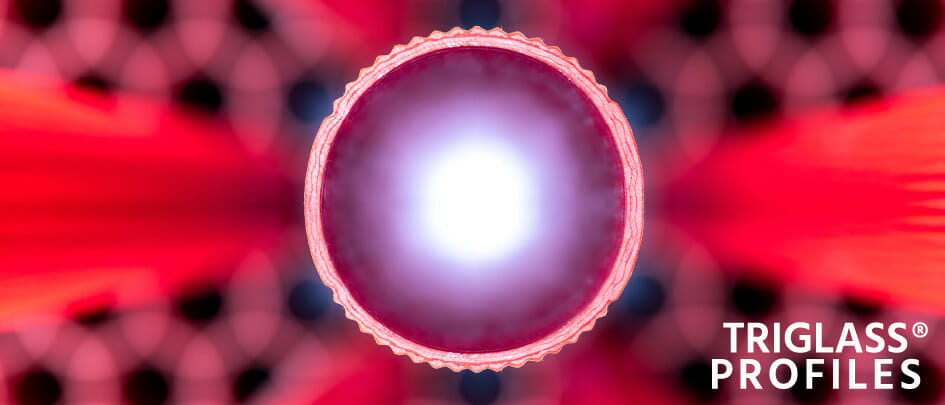4 reasons why Composites are replacing other materials

Composite profiles are replacing traditional materials like aluminum and steel because of their unique characteristics that make them an ideal solution for engineers, technicians and designers.
In this article we explain the 4 main reasons why.
High strength to weight ratio
The lightweight combined to the high mechanical resistance makes fiberglass GRP material the unique solution for many fields of application such us transportation, construction and energy infrastructure.
TRIGLASS® profiles are 70% lighter than steel and 30% lighter than aluminum but at the same time are very resistant and strong.
The mechanical properties of composites are generally high in the longitudinal direction, which coincides with the direction of the pultrusion process. Resistances in that direction are comparable to those of steel with an elastic-brittle behavior.
The abovementioned exclusive properties make the TRIGLASS® profiles easy to handle, transport and install. This saves a lot of time on projects and simplify the installations in remote locations. Composite has also a low response to inertial forces, relevant for building structures in seismic areas.
See the case history about the roof made of fibreglass profiles made in the province of Aquila.
Durability
Composites have an excellent ability to withstand environmental agents and highly aggressive chemicals especially acids, alkaline substances and solvents. Compared to other metal materials they never rust. Beyond this, their high dimensional stability allows them to stands up very well in large temperature fluctuations without presenting significant or permanent sectional deformation.
Engineers choose composites over traditional materials to reduce maintenance costs which are traditionally high for equivalent structures made in wood and metal. TRIGLASS® profiles are used in chemical, oil & gas and off shore systems for walking surfaces, scaffolds, handrails system and gangways.
The intrinsic durability makes TRIGLASS® profiles very popular for outdoor structures. They are used for the construction of walkways, handrails, architectural elements and furnishings, poles and fences.
Design Flexibility
Reinforcement, matrix and additives can be combined in innumerable ways in order to meet specific customer requirements and to obtain profiles with particular physical and mechanical properties.
Every key aspect related to the profile design can be easily customized: dimensions, thickness, form complexity, appropriate raw materials and mechanical specifications.
The inherent features and versatility of TRIGLASS® special profiles make them an ideal solution for engineers and technicians who recognize the unique advantages of composite materials over traditional ones. Designers are free to create exciting new products and, in many cases, are only limited by their imagination.
Insulation
TRIGLASS® profiles don’t require grounding thanks to their high level of electrical insulation and their low coefficient of thermal conductivity ensuring a one of a kind thermal insulation.
Fibreglass materials have a thermal conductivity coefficient around 0.3 W/mK that is incredible low compared to aluminum and steel. For this reason they have found large application in windows and doors where they make a fundamental contribution to energy saving.
Some technical DATA
| PROPERTY | UNIT | TRIGLASS® | STEEL | ALUMINIUM | WOOD |
| Thermal Conductivity | W/m°C | 0,25 ÷ 0,35 | 30 ÷ 60 | 100 ÷ 230 | 0,12 |
| Specific weight | g/cm3 | 1,85 | 7,8 | 2,7 | 0,5 ÷ 0,9 |
| Tensile strength | MPa | 400 ÷ 500 | 370 ÷ 500 | 200 ÷ 400 | 16 ÷ 26 |
| Tensile elongation | % | 1,5 ÷ 2,0 | 15 ÷ 35 | 10 ÷ 45 | 0,5 ÷ 2 |
| Tensile modulus | GPa | 25 ÷ 30 | 210 | 70 | 10 ÷ 15 |
| Flexural modulus full scale | GPa | 25 ÷ 30 | 210 | 70 | 10 ÷ 15 |
| Impact resistance | KJ/m2 | 170 ÷ 220 | 400 | 200 | – |
| Coefficient of thermal expansion | °C-1 | 9 ÷ 12×10-6 | 10 ÷ 14×10-6 | 20 ÷ 25×10-6 | 5 ÷ 6×10-6 |
| Dieletric strenght | KV/mm | 5 ÷ 7 | – | – | – |
| Corrosion and wear resistance | – | EXCELLENT | LOW | GOOD | LOW |
